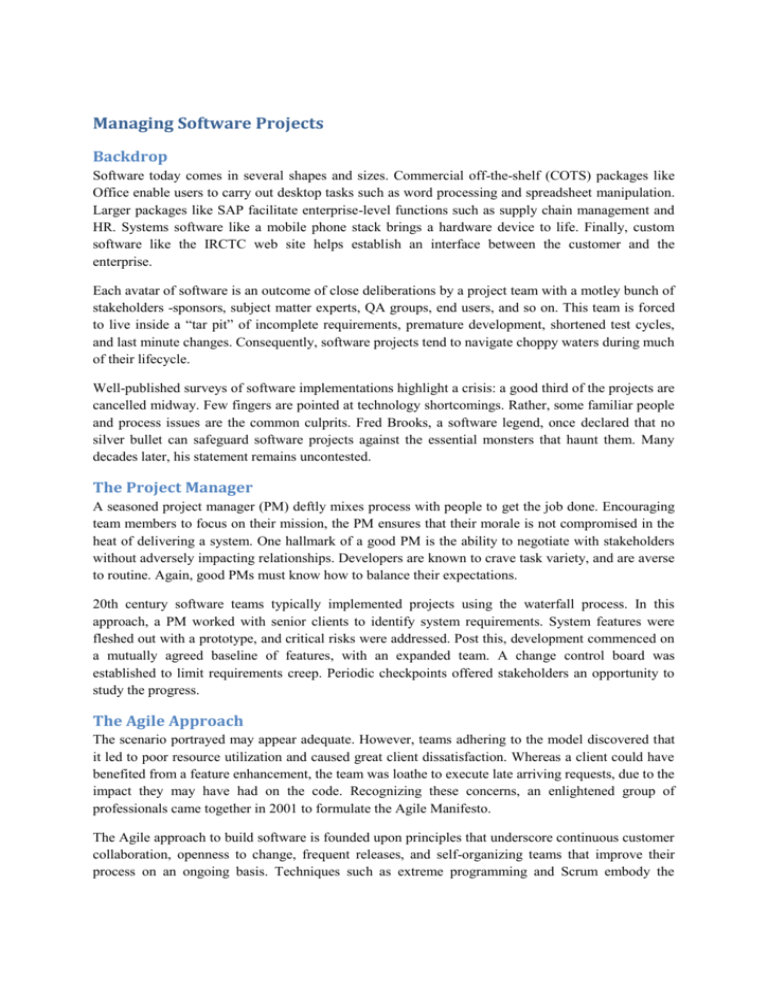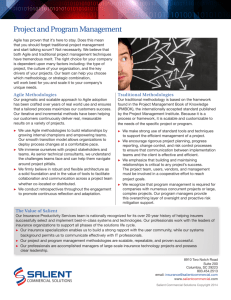MSP,SV - Spidi - Indian Institute of Management Bangalore
advertisement

Managing Software Projects Backdrop Software today comes in several shapes and sizes. Commercial off-the-shelf (COTS) packages like Office enable users to carry out desktop tasks such as word processing and spreadsheet manipulation. Larger packages like SAP facilitate enterprise-level functions such as supply chain management and HR. Systems software like a mobile phone stack brings a hardware device to life. Finally, custom software like the IRCTC web site helps establish an interface between the customer and the enterprise. Each avatar of software is an outcome of close deliberations by a project team with a motley bunch of stakeholders -sponsors, subject matter experts, QA groups, end users, and so on. This team is forced to live inside a “tar pit” of incomplete requirements, premature development, shortened test cycles, and last minute changes. Consequently, software projects tend to navigate choppy waters during much of their lifecycle. Well-published surveys of software implementations highlight a crisis: a good third of the projects are cancelled midway. Few fingers are pointed at technology shortcomings. Rather, some familiar people and process issues are the common culprits. Fred Brooks, a software legend, once declared that no silver bullet can safeguard software projects against the essential monsters that haunt them. Many decades later, his statement remains uncontested. The Project Manager A seasoned project manager (PM) deftly mixes process with people to get the job done. Encouraging team members to focus on their mission, the PM ensures that their morale is not compromised in the heat of delivering a system. One hallmark of a good PM is the ability to negotiate with stakeholders without adversely impacting relationships. Developers are known to crave task variety, and are averse to routine. Again, good PMs must know how to balance their expectations. 20th century software teams typically implemented projects using the waterfall process. In this approach, a PM worked with senior clients to identify system requirements. System features were fleshed out with a prototype, and critical risks were addressed. Post this, development commenced on a mutually agreed baseline of features, with an expanded team. A change control board was established to limit requirements creep. Periodic checkpoints offered stakeholders an opportunity to study the progress. The Agile Approach The scenario portrayed may appear adequate. However, teams adhering to the model discovered that it led to poor resource utilization and caused great client dissatisfaction. Whereas a client could have benefited from a feature enhancement, the team was loathe to execute late arriving requests, due to the impact they may have had on the code. Recognizing these concerns, an enlightened group of professionals came together in 2001 to formulate the Agile Manifesto. The Agile approach to build software is founded upon principles that underscore continuous customer collaboration, openness to change, frequent releases, and self-organizing teams that improve their process on an ongoing basis. Techniques such as extreme programming and Scrum embody the philosophy of Agile, and are being embraced by teams and organizations worldwide, even on large efforts. Managing Software Projects: The Course This 20-session course is designed for an audience with at least 2-years of acquaintance with the software industry. The course has two main goals: To appreciate process neutral aspects of software management, specifically with regards to system requirements, scope management, and so on. To equip the participant with a working knowledge of Agile. A hands-on project shall expose teams of participants to the dynamics of an agile effort Here are some objectives on the people and process dimensions of software projects. People Process Facilitate meetings and brainstorms Participate in a contract negotiation Provide individual and team feedback Manage the client relationship Elicit and capture project requirements Estimate the effort for a project Schedule a project using the WBS Establish quality assurance mechanisms Make no mistake, this is an intense program on project management. It employs a mix of instructorled discussions, inputs from industry professionals, and participant insights. Exercises on brainstorming, negotiation and estimation, captured on video for a debrief, shall give participants a realistic feel for these “routine” activities. Finally, all participants are expected to work in small groups on a tight-paced project assignment. For a course on Managing Software Projects to have any substantive effect, a student must prepare for each session (many will have caselets) and attend class at least 80% of the time. It's a course on project management, after all! Schedule No. / Topic Assigned / reading 1 The World of Software Brooks, Fred. No Silver Bullet: Essence and Accidents of Software Engineering. IEEE Computer (1987) 2 What can go wrong? McConnell, S. Rapid Development. Case on Classic Mistakes 3 Risk management McConnell, S. Rapid Development. Case on Risk Management Boehm, B. Software Risk Management: Principles and Practices. IEEE Software (1991) 4 Methodologies Larman, C. Iterative, evolutionary and agile, in Applying UML and Patterns (2004) 5 Project requirements Fairley, R. & Wilshire, M. Why the Vasa sank: 10 problems and antidotes for software projects. IEEE Software (2003) 6 Refining requirements Ross, P. The Exterminators. IEEE Spectrum (2005) 7 Brainstorm (Interactive exercise) Doyle, M. and Straus, D. Facilitation from How to make meetings work. Berkley Reprint (1993) 8 The Agile Approach Schwaber, K. The Scrum Guide 9 User stories Web links 10 The Agile Workshop (Guest lecture) Longstreet, D. The Agile Method and other fairy tales 11 Estimation McConnell, S. Rapid Development. Case on Estimation 12 Planning Poker (Interactive exercise) Web links 13 Software Costing Venkatagiri, S: Destination Saptadweep 14 Negotiation analysis Sebenius, J.K. The hidden challenge of cross-border negotiations. Harvard Business Review (2002) 15 Negotiation (Interactive exercise) Case handed out in advance 16 Software Testing Whittaker, J.A. What is software testing? And why is it so hard? IEEE Software (2000) 17 Project Metrics Kulik, P. A practical approach to software metrics. IT Pro (2000) 18 Question of quality Fishman, C. They write the right stuff. FastCompany (1996) 19 Peopleware Web links 20 Presentations Project Presentations A copy of Steve McConnell’s classic on project management titled Rapid Development1 shall be made available to each participant. This book contains crisp caselets in a realistic software setting. We shall be discussing the caselets daily. It is expected that the participants shall jointly work with their respective project groups on these caselets. Faculty Profile Shankar Venkatagiri is a faculty member in the Quantitative Methods & Information Systems area at Indian Institute of Management Bangalore (IIMB). His interests are in open source software, software project management and educational technologies. Shankar began his professional career at Sapient Corporation, Cambridge, where he consulted with clients in the energy and healthcare sectors. He then developed bandwidth-efficient Internet applications at Curl Corporation, an MIT-based technology start-up. As a senior consultant with Reuters Consulting, he worked with brokerage firms and banks in the role of a solutions architect. At IIMB, Shankar has chaired the long duration PGSEM program, which is targeted at professionals in the software industry. With over six years of experience in the industry, he has developed a keen appreciation for the various facets of software management. He has also conducted project management training at prominent firms like NDS. An alumnus of IIT Kharagpur, University of Southern California and Georgia Tech, Shankar holds a doctorate in mathematics and a masters degree in computer science. 1 http://www.amazon.com/Rapid-Development-Taming-Software-Schedules/dp/1556159005







